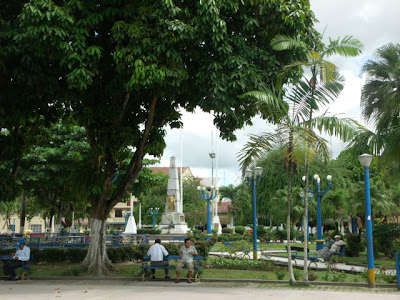Located at the confluence of the Itaya, Nanay, and Amazon rivers, Iquitos is the capital of Maynas province and of the the department of Loreto, and, at about half a million inhabitants, is the largest city in the Peruvian Amazon.
It is also the largest city in the world that is inaccessible by road.
 |
| Plaza de Armas |
After the blackout was resolved, we went to the Plaza de Armas to look around and were greeted by swarms of thumb-sized black papazo dung beetles, evidently animated by the rain, flying about every lightpost and lumbering on the sidewalks below.
Iquitos is definitely a city, not just a large town, but for all that it remains pretty basic in its amenities. The fact that it is relatively cut off from the rest of the world, and that everything must be brought in by plane or by boat is subtly evident. There is, for example, a noticeable dearth of internet cafes and small corner grocery stores, both of which are a common feature in other Peruvian cities. Similarly, other than the tourist bars and eateries near the Plaza de Armas and the Malecón -the riverfront boulevard near downtown- there are not that many restaurants and bars in town, which is a little surprising given the number of visitors the city receives.
 |
| The Malecón |
Cars, not surprisingly, are an infrequent sight in Iquitos. There is a small fleet of buses that ply several routes in and around the city, but the bulk of traffic consists of motorcycles and mototaxis -the motorcycle rickshaws common to provincial Peru. In other cities -Ayacucho, for example- the mototaxis are somewhat regarded as a plague, crowding city streets and adding noise to the environment, but in Iquitos they feel like a natural part of the city. With their open sides, they certainly are a pleasant way to travel on a hot, humid, afternoon.
Iquitos' days of splendor were during the rubber and cacao booms of the 19th and early 20th centuries, when it was the richest city in Peru. That wealth is reflected in the city's downtown, where it is common to see what were formerly the grand homes of the city's rich still reflecting the grandeur of days past.
 |
| The former Palace Hotel |
Unlike the Sierra and the coast's a bit more staid architecture, Iquitos' older buildings tend to reflect a lighter aesthetic, with tall ceilings, thin columns, large windows, and lots of open space through which air can flow to counteract the jungle heat. Reflecting the wealth of their former owners, many buildings are covered in tiles, which would have had to have been brought 2000 miles up the Amazon River from the Atlantic Ocean.
Perhaps the greatest example of such extravange is the Casa de Fierro, or "metal house". It is also known as the Casa Eiffel, which leads some to believe that Gustave Eiffel, the designer of the the Eiffel Tower once lived there. In fact, the building is another of Eiffel's designs.
 |
| The Casa de Fierro |
Made entirely of iron, it was constructed in Belgium in 1889. It was then purchased by Bolivian rubber magnate, Antonio Baca Diez, who had it disassembled and shipped to Peru in 1890, for eventual installation in Madre de Dios, then the center of rubber extraction. Finding the project to be prohibitively difficult in practice, Baca Diez then sold the building to another rubber magnate, Spanish baron Anselmo del Aguila, who had it assembled in Iquitos. Originally placed on the waterfront, it was again disassembled in 1899-1900 and moved to its present location on the Plaza de Armas.
Another prominent feature downtown is an imposing but decrepit building that was at one time a public building of some sort but suffered a devastating fire. That was about 25 years ago, and the gutted ruin still stands overlooking the Plaza de Armas. Today it sprouts a large radio antenna from its roof, and various forms of plant life elsewhere.
Liz was right about Iquitos on several counts. She said it was different from other cities we'd been to, and she said I'd like it. It was different and I did like it.
In Iquitos there seems to be a pace of life that is even more relaxed than in the Sierra, but at the same time one gets a sense of how much harder life must be, and how much more limiting it must be, to be so isolated. Nonetheless, people overall seemed relaxed and friendly in a way that is a bit different than in other parts of the country.
In future posts I'll go into more details about our activities there...
Another prominent feature downtown is an imposing but decrepit building that was at one time a public building of some sort but suffered a devastating fire. That was about 25 years ago, and the gutted ruin still stands overlooking the Plaza de Armas. Today it sprouts a large radio antenna from its roof, and various forms of plant life elsewhere.
Liz was right about Iquitos on several counts. She said it was different from other cities we'd been to, and she said I'd like it. It was different and I did like it.
In Iquitos there seems to be a pace of life that is even more relaxed than in the Sierra, but at the same time one gets a sense of how much harder life must be, and how much more limiting it must be, to be so isolated. Nonetheless, people overall seemed relaxed and friendly in a way that is a bit different than in other parts of the country.
In future posts I'll go into more details about our activities there...



No comments:
Post a Comment